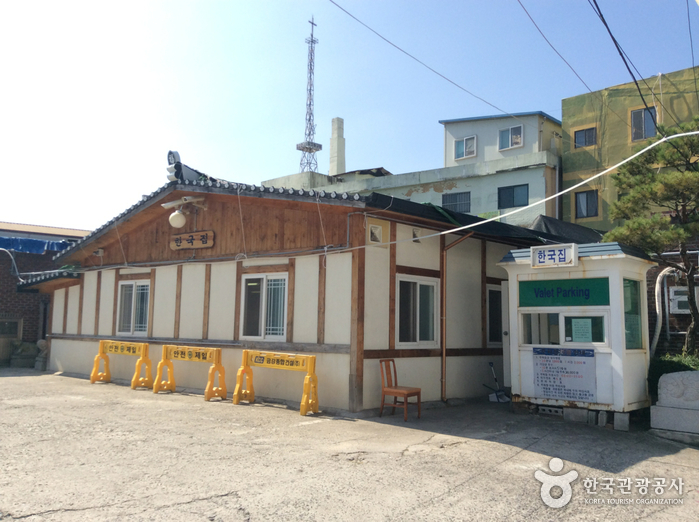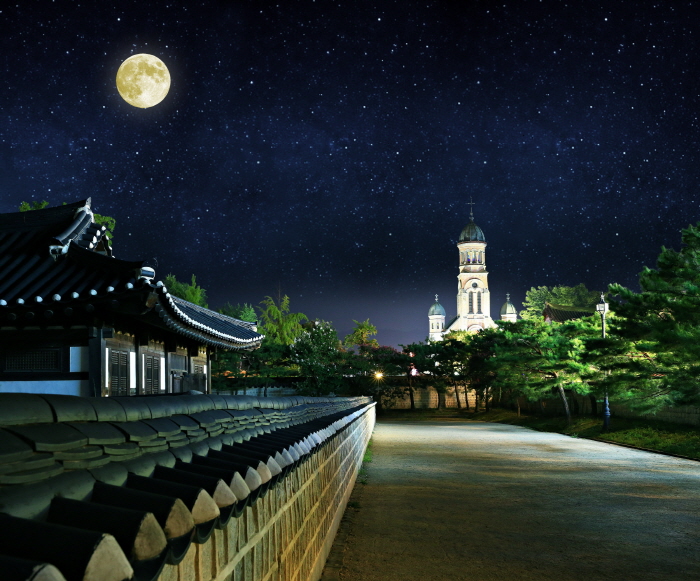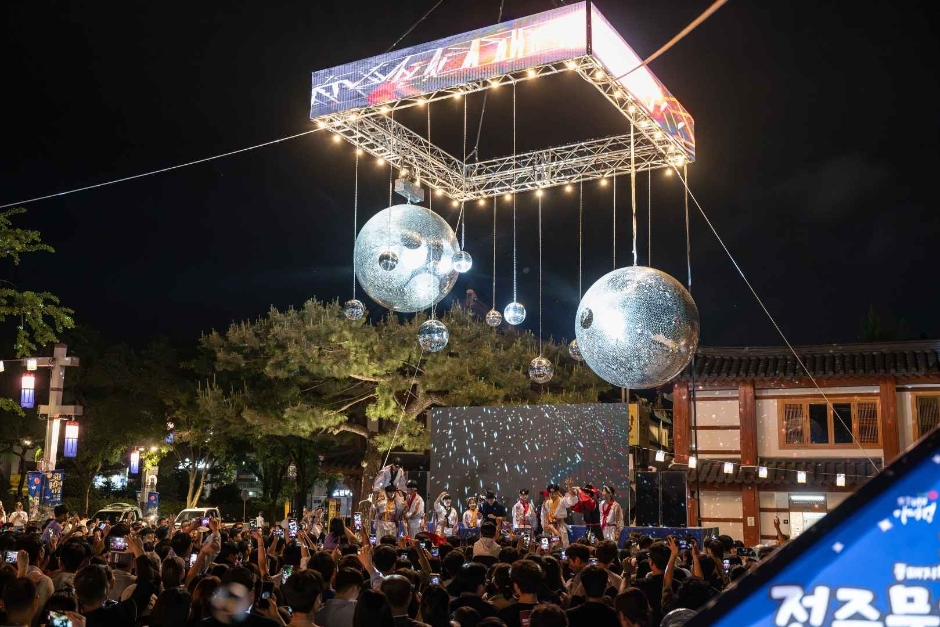Bangjjanotjeon [Tax Refund Shop] (방짜놋전)
167.70300029999586m 0 2024-04-22
28, Pungnammun 4-gil, Wansan-gu, Jeonju-si, Jeollabuk-do
-
Han Kook Jib (한국집)
173.0403585912987m 14711 2024-04-07
119, Eojin-gil, Wansan-gu, Jeonju-si, Jeonbuk-do
+82-63-284-0086, 2224
Han Kook Jib was the first Korean restaurant to sell jeonju bibimbap since 1952, boasting a tradition that has been passed down through three generations. The restaurant offers dishes such as jeonju bibimbap, doenjang jjigae (soybean paste jjigae), yukgaejang (spicy beef soup), dolpan bulgogi (stone-grilled bulgogi), which are made using Korean ingredients like red chili paste, soybean paste, and soy sauce.
Kakao Friends - Jeonju Hanok Village Branch [Tax Refund Shop] (카카오프렌즈 전주한옥마을)
179.81738849651475m 0 2024-04-19
1F, 126, Paldal-ro, Wansan-gu, Jeonju-si, Jeollabuk-do
-
Jeonju Pungnammun Gate (전주 풍남문)
203.6644421421263m 29321 2024-04-07
1, Pungnammun 3-gil, Wansan-gu, Jeonju-si, Jeonbuk-do
+82-63-287-6008
Pungnammun Gate was built during the Joseon dynasty in 1734 and is a designated Treasure. Pungnammun Gate was the southernmost gate among the four city gates of Jeonju. The structure was severely damaged by fire in 1767, followed by the restoration of the gate tower afterward. The gate was burnt down once again during the Imjin War and was restored to the gate that is seen today.
Royal Portrait Museum (어진박물관)
218.88488539793374m 19472 2024-04-07
44, Taejo-ro, Wansan-gu, Jeonju-si, Jeonbuk-do
+82- 63-231-0090
Opened on November 6, 2010, the Royal Portrait Museum is one of the newest attractions of Jeonju, located within the Gyeonggijeon Shrine. Royal Portrait Museum is a valuable museum as a new tourism resource of Jeonju as well as Gyeonggijeon Shrine and the Portrait of King Taejo, as well as other various high-class exhibitions to preserve, manage, and enhance the glorious cultural assets of Joseon royal family. The museum is comprised of one above-ground level and one underground level with an area of 1,193.71 square meters. The Portrait of King Taejo and six other king’s portraits (Portrait of King Sejong, King Yeongjo, King Jeongjo, King Cheoljong, King Gojong, and King Sunjong) are exhibited on the first floor. The portraits are preserved in temperature- and humidity-controlled cases. In addition, the museum houses History Hall, Palanquin Hall, a planned exhibition hall, resting area, management office and storage room for relics. Palanquin Hall exhibits Hyangjeong (Palanquin for Incense Burner and Case), Sinyeon (Palanquin for Royal Portrait and Palanquin for Mortuary Tablet), Chaeyeo (Palanquin for High Officials), Gagyo (Palanquin for Ritual Items) featuring Korea’s sole preserved palanquin. History Hall houses approximately 80 relices related to Gyeonggijeon Shrine and Jogyeong Shrine, ancestral ritual ceremony, building, and others relics. Since the museum's opening, it makes continual efforts to become a central place for Jeonju residents to fulfill their cultural feelings. The museum operates various program like exploring famous historic sites in Gyeonggijeon Shrine, hands-on programs such as a guard experience to protect the shrine, and duplicating Gyeonggijeon Shrine’s relics using traditional portrait-making techniques.
Walk with a King (전주 한옥마을 경기전 왕과의 산책)
218.88488539793374m 8857 2024-04-07
44, Taejo-ro, Wansan-gu, Jeonju-si, Jeonbuk-do
• 1330 Travel Hotline: +82-2-1330 (Korean, English, Japanese, Chinese) • For more info: +82-63-232-9938
Walk with a King is a special event held every Saturday evening from late spring to autumn. Limited to 100 people, the guided tour shows a special view of Gyeongggijeon Shrine at night, with entertainment and refreshments.
Gyeonggijeon Shrine (경기전)
229.678437672504m 55855 2024-04-07
44 Taejo-ro, Wansan-gu, Jeonju-si, Jeonbuk-do
+82-63-281-2790
Historic Site, Gyeonggijeon Shrine was erected in 1410 and holds the portrait of King Tae-jo, the founder of the Joseon dynasty. The shrine was originally given the name Eoyongjeon, but was changed to its current name in 1442, the 24th year of King Sejong the Great. The structure was partially destroyed during the Imjin War (1592-1598), and was restored in 1614.
Gajok Hoegwan (가족회관)
241.41896745229408m 39855 2024-04-07
17 Jeollagamyeong 5-gil, Wansan-gu, Jeonju-si, Jeonbuk-do
Gajok Hoegwan is a restaurant specializing in Jeonju bibimbap. The restaurant opened in the 1970s, and its signature menu is Jeonju bibimbap, which is light and flavorful with a combination of freshly cut vegetables, meat, bean sprouts, and eggs. The restaurant is built in a hanok, giving it a traditional Korean atmosphere. It's a favorite among locals and tourists alike.
Jeonju Cultural Heritage Night Tour (전주문화유산야행, 다 같이 전주마블!)
266.7982597927545m 11471 2024-04-18
44 Taejo-ro, Wansan-gu, Jeonju-si, Jeonbuk-do
+82-63-232-9937
Jeonju Cultural Heritage Night Tour focuses on preserving and remembering Korea’s heritages and the ancestors’ spirits. Jeonju features many historical sites from the Joseon dynasty and traditional culture.
Jeondong Catholic Cathedral (전주 전동성당)
268.62573816393444m 52000 2024-04-07
51 Taejo-ro, Wansan-gu, Jeonju-si, Jeonbuk-do
Jeondong Catholic Cathedral in Jeonju (Historic Site) was built in honor of Roman Catholic martyrs of the Joseon dynasty on the very same spot the martyrs lost their lives. The land was purchased by French Priest Baudenet in 1891 (28th year of King Gojong), but construction of the church did not begin until 1908. The church was designed by Priest Poinel, who also designed the famous Myeongdong Cathedral in Seoul. Construction was completed in 1914, a time during which Korea was under Japanese rule. Though originally built just outside of Pungnammun Gate, the site of the martyrs, the church was later moved to its current location for expansion.
The first Romanesque building in the Honam region, Jeondong Catholic Cathedral is made of gray and red bricks and bears a striking resemblance to the Myeongdong Cathedral in Seoul. Not only considered one of the most beautiful Catholic churches in Korea, some even go so far as to say it is one of the most beautiful structures in all of Korea, citing the church’s unique combination of Byzantine and Romanesque architectural styles. The rectangular building is topped with three Byzantine bell towers (to the right, center, and left) and boasts arched ceilings, several of which meet in the form of a cross.
It is interesting to note that some of the bricks used in construction of the church were made using materials from the Jeonjueupseong Walled Town, which was torn down by the Japanese. It is also said that the cornerstone of the church came from a wall of Jeonjueupseong Walled Town near Pungnammun Gate.







 English
English
 한국어
한국어 日本語
日本語 中文(简体)
中文(简体) Deutsch
Deutsch Français
Français Español
Español Русский
Русский